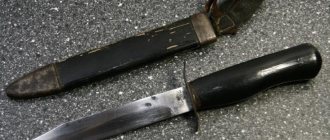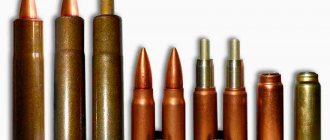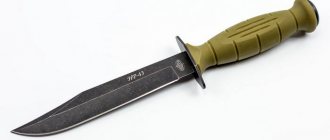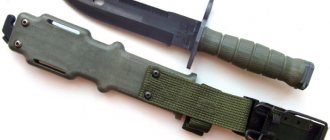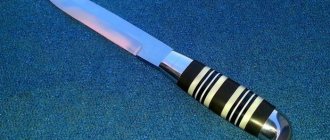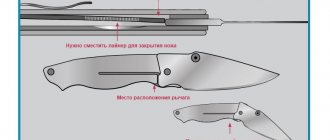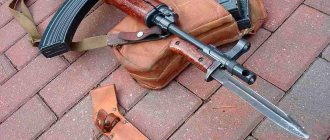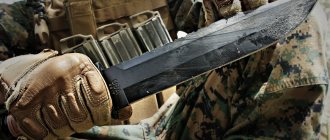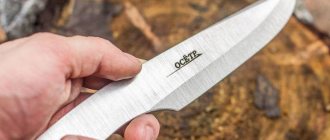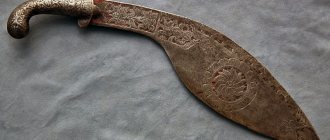Scout Knife Shooting NRS, NRS-2 (USSR / Russia)
Scout Knife Shooting LDC. The barrel is removed from the handle for reloading
Scout Knife Shooting NRS-2 complete with sheath and pouch with SP-4 cartridges
Scout Knife Shooting NRS-2 in shooting position
Scout Shooting Knife NRS-2. The trigger cocking lever is visible on the side surface of the handle
Scout Shooting Knife NRS-2, controls: release button under the thumb and safety.
Scout Knife Shooting NRS-2, sighting devices (front sight in the top of the handle and rear sight in the guard)
Scout Shooting Knife NRS-2. Removing a spent cartridge case from a barrel removed from the knife handle for reloading.
Data for NRS-2.
| USM | single action |
| Caliber | LRS: 7.62x35 SP-3 LRS-2: 7.62x40 SP-4 |
| Weight | 0.57 kg loaded in sheath |
| Length | 290mm |
| Barrel length | 60 mm |
| Capacity | 1 cartridge |
The reconnaissance knife shooting NRS (GRAU index 6P25) and its development NRS-2 (6P31 “Vzmakh”) is one of the most unusual, and probably the least used types of special weapons developed in the USSR in the seventies of the 20th century. The NRS shooting knife combines the reconnaissance combat knife itself with a single-shot firing device built into its handle for silent special cartridges (SP-3 for the NRS and SP-4 for the NRS-2). On the basis of the NRS and NRS-2 shooting knives, ordinary reconnaissance combat knives NR and NR-2 were also produced, which were distinguished by a handle without a built-in firing mechanism. The reason for the low popularity of LDCs for use in real combat missions is the inconvenience of shooting and the inability to quickly reload for a second shot. From this point of view, the NRS and NRS-2 knives are noticeably inferior to the silent MSP and PSS pistols chambered for the corresponding cartridges. As a knife, NRS and NRS-2 can be used as a hand-to-hand weapon, as a household item, and also (complete with a sheath) as a tool for cutting wire, crimping detonators and other needs.
The reconnaissance knife shooting NRS-2 differs from the NRS primarily in the use of a more advanced and powerful silent cartridge 7.62x40 SP-4 instead of 7.62x35 SP-3. NRS-2 also has a slightly modified blade shape. Both versions of the shooting knife were produced in Tula at the Tula Arms Plant (TOZ). Formally, the target firing range of the LDC is 25 meters, but in a real combat situation, firing from the LDC is possible only at the shortest distances.
The reconnaissance shooting knife NRS is a knife with a fixed blade 160 mm long and a hollow plastic handle. A single-shot shooting device with a short barrel directed in the direction opposite to the blade is inserted into the cavity of the handle from the back side. The firing device consists of a detachable barrel with a chamber and a firing mechanism block. To load, the barrel is removed from the handle and a cartridge is inserted into it. The barrel is then placed back into the weapon handle and secured in it. The trigger mechanism is cocked using a special lever located on the side surface of the knife handle. At the top of the handle there is a small (and inconvenient) safety lever and a release button. Sights consist of a rear sight slot made in the knife guard, and a front sight located at the top of the handle. The peculiarity of the knife's sighting devices is that normal aiming is possible only with the sheath removed, so that when firing, the shooter is forced to hold the knife with the tip of the blade pointed at his face. Shooting from a knife in a sheath is possible, but the sheath blocks the aiming line. After firing, to reload, it is necessary to remove the barrel with the spent cartridge case from the handle and then, using a special cutout in the knife guard as a hook, remove the cartridge case from the chamber.
It should be noted that shooting from the LDC itself with the scabbard removed is not too dangerous for the shooter due to the very small, almost imperceptible recoil when fired. However, in combat conditions such shooting is very inconvenient, especially if you need to shoot from an unstable position or while moving.
The history of the creation of the scout knife
The scout knife, as a separate concept, appeared only during the Second World War. And before that, the soldiers did not have their own bladed weapons, although many carried pocket knives with them - small in size, of poor quality. The reason for the creation of the scout knife was the Russian-Finnish war, during which the enemy successfully “removed” the sentries and used the same weapon in the household.
The command of the Red Army was forced to give the order to develop a scout knife, and it was created, put into mass production and entered service with soldiers in 1940. The original name was NA 40 (machine gunner's knife), but then it was changed to HP 40 (scout knife).
Scout knife HP 40
The prototype was the Finnish puukko knife - this is the official version, although the Soviet weapon was practically nothing like the classic “Finnish knife”. There is also a “folk” version that a gangster “finka” was used as a model when creating a scout knife, the design of which was supplemented with a “fungus” guard at the end of the handle.
Finnish puukko knife
Regardless of what kind of weapon the developers chose as a model, the scout knife gained incredible popularity, survived all the years of the Second World War and still remains in demand. Some modern manufacturers produce HP 40 from Damascus steel and are experimenting with models.
What is HP 40: characteristics, weight
The weight of the HP 40 is small and without a sheath is only 110 g, but its characteristics are so high that with a knife you can cut thin branches, open cans, and cut thick cords.
| Characteristic | Options |
| Knife length – blade + handle | 263 mm |
| Blade length | 152 mm |
| Blade width at widest point | 22 mm |
| The thickness of the butt at its thickest point | 2.6 mm |
| What is the blade made of? | Steel U7 |
| Handle material | Tree |
In addition to these standard parameters, it is worth knowing the following about the scout knife:
- the blade is made with a beveled butt;
- the slopes are located half the width of the blade;
- There is a heel in front of the guard, which allows you to safely move your index finger onto the blade.
The handle and scabbard were made of wood and always painted black - this was necessary to camouflage scouts during night military operations, but the blade itself was never covered with anything. The knife was recommended to be worn on a belt/belt on the left side so that the angle to the body was 30 degrees, and the handle of the weapon “looked” to the right.
We recommend reading about what a German bayonet is. From the article you will learn about famous products of bayonet knives from the German WWII, a description of the best models of Wehrmacht knives, and characteristics of the Mauser 98k bayonet knife. And here is more information about the best switchblades of domestic and foreign production.
Production
Initially, the production of scout knives was carried out at two (the village of Vacha) and the Zlatoust Tool Plant No. 259 named after V.I. Lenin. Most of all HP 40 ever produced were produced in Zlatoust, and the peak of production occurred in 1942-1943:
- in 1942, the Zlatoust plant produced 261,000 knives;
- in 1943 - 388,000 pieces.
Scout knife HP 40, 1943.
Scout knives were produced not only in production, but also in artisanal enterprises. In this case, the knives were decorated, for example, the handle was made inlaid, for which modern materials such as plastic were used. Nowadays, exact copies of the scout knife are produced by various manufacturers.
Application
In 1940, it was decided to develop and “release to the masses” a knife because machine guns and machine guns began to enter service. But their design is not characterized by the presence of a bayonet-knife, and the soldiers were left without any bladed weapons at all. During the same period, techniques for working with a short Finnish/Norwegian knife were included in the sambo system, and in 1941 they were added to the “Guide to preparing for hand-to-hand combat in the Red Army.”
Since the scout knife is a classic edged weapon, its presence in the soldier’s possession was necessarily regulated by entering data about it into the Red Army soldier’s book.
Modern manufacturers also produce souvenir scout knives, which can be either an award or a gift weapon - in this case, engraving is done on the blade.
Watch this video about the characteristics and use of the HP 40 scout knife:
Drawing of HP 40 scout knife
To make an HP 40 (scout knife) with your own hands, you will need a drawing that can be found on the Internet. Experts do not recommend taking modern modifications of weapons as a model; it is better to opt for the classic version.
How to make it yourself
A knife is made with your own hands according to the following algorithm:
- Prepare a blade pattern according to the drawing from cardboard or any thick paper.
- A metal plate from an old spring is placed on a flat surface.
- A pattern is attached to the top, and the contours of the future blade are outlined with a construction marker.
- The workpiece is cut out with a hacksaw, the edges are filed, and all irregularities and roughness are removed.
- On a grinding machine, the workpiece is ground and sharpened, maintaining the bevels on the blade.
- The blade is installed in a wooden handle using a mounted method. Attached with glue.
- The blade is sharpened and the handle is coated with black paint.
A scout knife, of course, belongs to the category of edged weapons; it is strictly forbidden to use such weapons in everyday life without a license - this is already a criminal offense. To prevent a homemade tool from falling into the “dangerous” category, you should do the following:
- reduce blade thickness to 2.4 mm;
- abandon the guard;
- do not sharpen the blade.
Watch this video on how to make HP 40 with your own hands:
